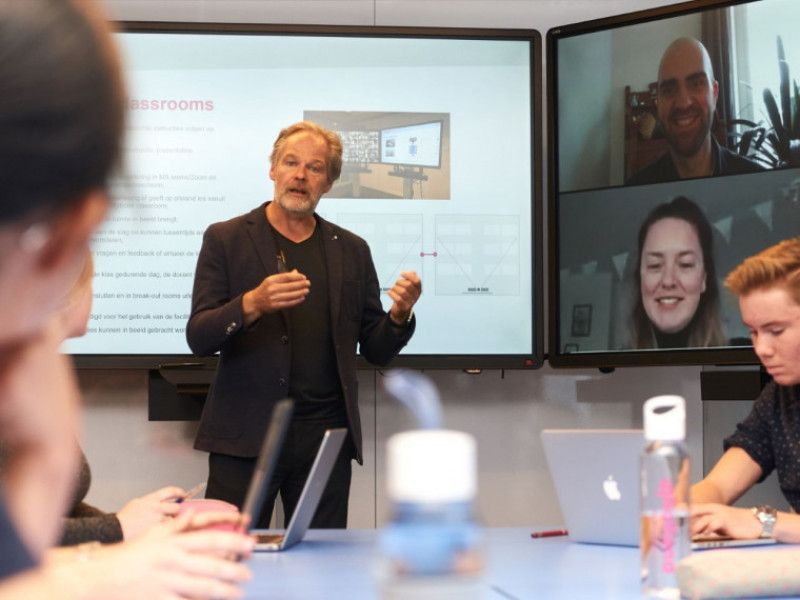Hybrid education has taken off in 2021. But what is hybrid education? And why do you need a hybrid classroom for it? How is it already being used at educational, what do teachers and students think of it and how is the technology arranged?
Technology hybrid classrooms
How do you develop a hybrid classroom and what components do you use? Be inspired and make your own decisions.
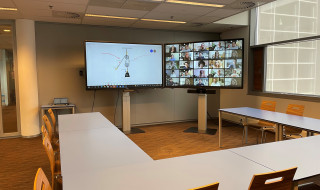
Hybrid Classroom Inholland
Technical components: Hardware and Software in Physical Spaces
To realise a hybrid classroom, your institution needs to invest in furniture but also in hardware and software. A survey conducted in the autumn of 2020 and a webinar with AV and IT experts held in March 2021 showed that solutions ranged from simple to high-tech. With a very diverse price indication from 100 euros to 100,000 euros.
In a few cases, the survey indicated that no additional investment was needed, because use was made, for example, of the existing recording facilities in a lecture hall. Most examples (65%) are in classrooms with up to 20 students physically present.
We describe the choices that can be made for the hardware and software in the physical space. We distinguish four sub-areas:
- Video
- Sound
- Sharing content
- Production
The choices you make depend on the chosen educational activities, desired image and professionalism, and the available budget.
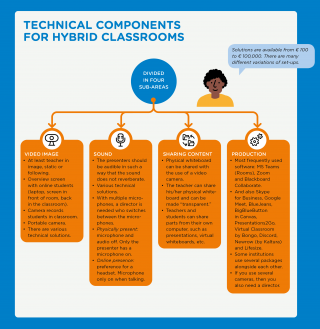
1. Video
You have to choose who and what you want to display. At a minimum, you need to display the speaker in front of the online students. You can also display the students in the classroom, for example when they ask questions. To achieve this, several camera and screen set-ups are available. You can also assess whether all participants in the class should also see the online students.
It is important to show the image of the accompanying presentation (PowerPoint or written text on a (digital) board) to all participants, both the online and the physically present students.
Considerations when choosing a camera setup
Make sure that at least the speaker is in the frame (static).
- Screen with overview of the online students
- on a laptop in front of the speaker
- or on a monitor in the front of the room so that the speaker and the students in the room can see the online students
- or (also) in the back of the classroom so that the speaker can see the online students
- Camera that records the students in the classroom (possibly handheld)
- Camera that captures the speaker (possibly a follow camera)
Components to achieve this
- Camera in the speaker's laptop or fixed PC
- Fixed monitor with internal camera and microphone for the speaker
- Conference camera that can follow the speaker
- Extra camera on the speaker and the (digital) board
- Extra camera to record the students
- Screen/TV/beamer (possibly with touch control) for the speaker
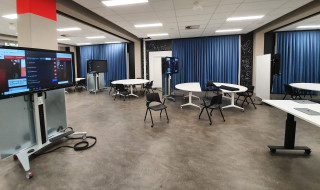
Hybrid Classroom Rijksuniversiteit Groningen
2. Sound
The sound of the speakers and questioners must be clearly audible to all participants, both in the room and online. It should not echo too much either. It is a challenge to achieve this.
Considerations
All participants have their sound set up correctly:
- The students in the room have the microphone of their laptop muted and their audio off by default.
- The speaker has the microphone on.
- The online students prefer to use a headset, and have the microphone turned off. Only when they ask a question, the microphone is switched on.
Possible technical solutions
- Reversing microphone or standing microphone or headset (speaking and hearing) for the speaker
- Fixed monitor with internal camera and microphone
- Additional separate microphone for students in the room or a Catchbox | Wireless microphone
- Ceiling microphones distributed in the room for all attendees
- Extra speakers in the room
- Special conference bar with integrated camera, microphone and speaker
3. Sharing Content
Often, content is also shared in the form of a presentation, application screen or whiteboard, using one's own computer online or on a linked screen.
Various technical solutions
- A physical whiteboard can be shared with a content camera. This may be a good webcam or the specially made Scribe whiteboard camera that records the whiteboard without showing the teacher.
- The teacher can share his physical whiteboard and can even be made "transparent" in Microsoft Teams Rooms (more information in this video on YouTube).
- Teachers and students can share parts of their own computer, such as presentations and virtual whiteboards, through a production tool (see below).
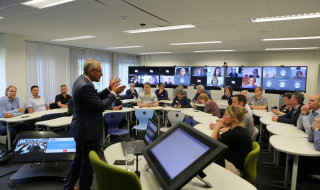
Hybrid Classroom, KU Leuven, campus Kortrijk (Tecol)
4. Production
Software
To connect the online and the physical situation, the institutions often use the software packages that became popular in the early 2020s. After all, from then on, the whole education sector was providing online education.
The following software packages are used:
|
Software package |
Number of times mentioned in the survey |
|---|---|
|
MS Teams (Rooms-version) |
18 |
|
Zoom |
7 |
|
Blackboard Collaborate |
6 |
|
Skype for Business Google Meet BlueJeans |
2 |
|
BigBlueButton in Canvas Presentation2go Virtual Classroom van Bongo Discord Newrow (by Kaltura) Lifesize |
1 |
Some institutions use several packages side by side.
Direction
In some rooms (often high end) there are a few cameras that capture the teacher and the students. (Student) assistants operate these cameras, a director directs the image. If several microphones are used in the room, they may also need to be directed. Sometimes the presenters and the director(s) are not in the same room.
Looking for further reading?
On 9 March, over 60 AV and IT experts shared their knowledge about the hybrid classroom. Four institutions showed how they had set up a new hybrid classroom and many tips and tricks were given about the organization, the relationship with the educational field and the future. Read the report of this meeting (in Dutch).
Advice from the AV and IT Expert Group
For the technology in a new hybrid classroom is of importance:
- Involve teachers and students in the choice of technology.
- Good accessible technology and good microphones and cameras are a prerequisite.
- Provide technical support for lecturers.
Hardware suppliers for the hybrid classroom
In the webinars we organized, a reasonable number of different suppliers of the required technology were mentioned:
- ATEM mini pr
- Crestron bars
- cRIO systems (NI)
- i3-technologies
- Jabra conferentiemicrophone & videoset
- Logitech meetups
- Logitech tap
- Magewell lecture capture
- Microsoft Teams Room System (MTR)
- Polycom Round-Table
- Polycom studio
- Prowise bord including camera,
- Presentation2Go motion tracking camera's
- Shure ceiling microphone
- Smartboards
Examples of Hybrid Classrooms
Below are 3 examples, from low end to high end, with the choices made in set-up and the 4 sub-areas.
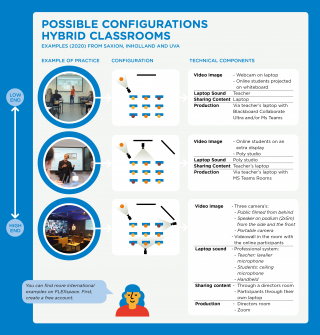
Note: Many institutions have already made AV and IT improvements to their hybrid classrooms in the first half of 2021.
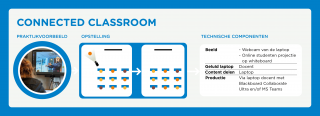
More examples
You can find more examples on the international platform FLEXspace.org (after a free login) where educational institutions share their examples of innovative educational spaces. The Classrooms from Belgium and the Netherlands gallery contains the examples that are also shown here, among others. There is also a gallery of worldwide hybrid learning spaces.
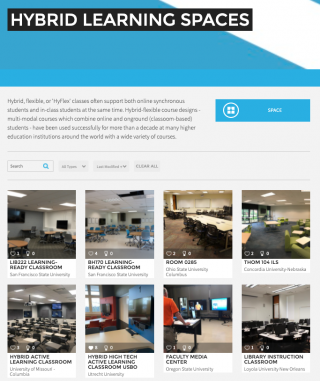
FLEXspace Hybrid Classrooms
